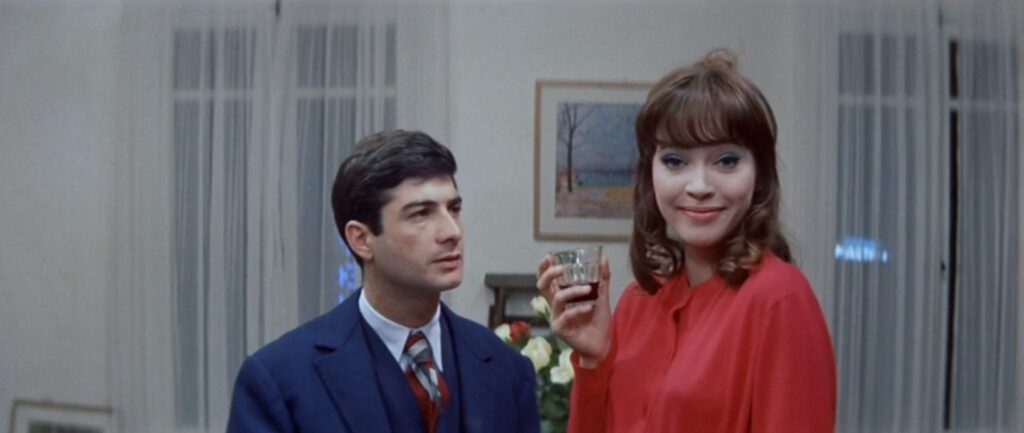
A Woman Is a Woman
1961, directed by Jean-Luc Godard
A Woman Is a Woman is full of little surprises and amusements. Angela interrupts a phone call to go back and catch an egg she tossed up from a frying pan. Émile rides a bike in loops around the small apartment. A jump cut cuts Alfred off as he yells upstairs to Angela, incongruously putting a song (“Hello there Joe, what do you know?”) into his mouth. Angela and her colleague magically change costumes by walking behind a pillar.
In most movies these gags would be one-liners inserted to spice up the action, with no particular relevance to the movie’s argument or plot. Here, however, they all shine a spotlight on the artifice of cinema. The egg makes us aware of continuity; the bicycle moves like a camera on a dolly; the pop song draws attention to the arbitrary use of music; and the jump cut and costume trick highlight the act of cutting. Unlike the “magical” cuts in a Méliès trick film, the angle shifts 180° around the pillar, revealing the artifice behind the trick.
Again and again A Woman Is a Woman exposes ubiquitous cinematic devices by refusing to hide them. When Angela winks at the audience, when she and Émile curtsey and bow to us, or when Alfred addresses us directly from the screen, they acknowledge the presence of the camera. During Angela’s song at the Zodiac strip bar, a rotating wheel of color filters reveals the artifice of film lighting. On the streets of Paris the soundtrack switches between silence, full ambient sound, selective sound effects, and musical overlay, exposing the invisible manipulations of film sound. Rapid montages make the act of editing transparent. When Angela performs a theatrical soliloquy, or when she and Émile compete to enunciate the letter “R”, their exaggerated gestures remind us that their performances are constructed. When Angela presses Émile on his dinner preferences (meat or fish?) he’s in a different part of the room at each question, calling attention to the rules of continuity.
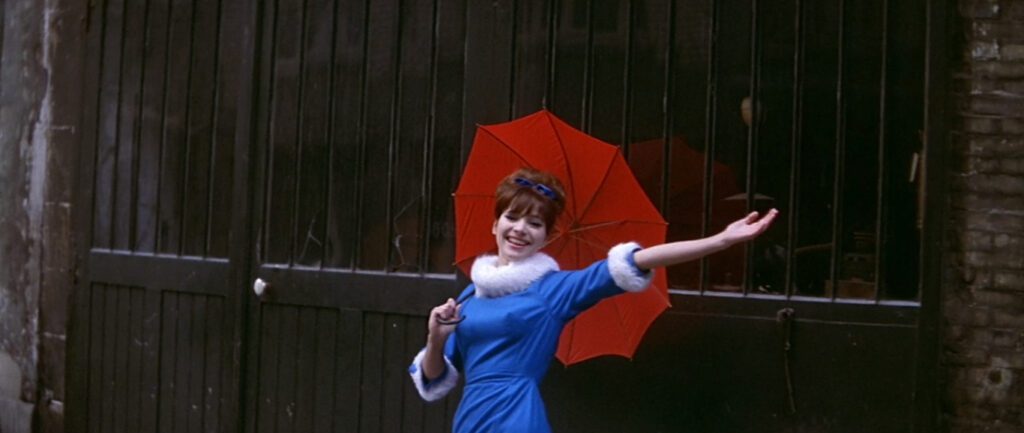
In numerous other ways we’re reminded that we’re watching a drama. During the opening credits we hear an orchestra tuning up and an audience settling in for a performance. The three leads are then introduced with “Lights, camera, action!” Characters repeatedly ask whether they’re in a comedy or a tragedy. Titles of other films – Breathless, Shoot the Piano Player, Jules and Jim – are dropped casually in the dialogue, reminding us that this too is a film of the Nouvelle Vague.
In this context it should be easier to see why Godard called A Woman Is a Woman “a neo-realist musical”. It’s not that the film avoids artifice or strives for the verisimilitude of Italian neo-realism. Rather it synthesizes the artificiality of musicals with the realist principles of André Bazin, the film theorist who launched Godard’s career. As long as the movie keeps reminding us it’s only a movie, it can adhere to Bazin’s ideal of realism while entertaining us with all the contrivances of a musical at the same time. More importantly though, we can also understand why Godard called this his “first real film”. Far more than his two previous features Breathless and The Little Soldier, this movie lays a foundation for the philosophy of his subsequent films. Its comic gestures that acknowledge the act of filming are not as frivolous as they seem, nor are they merely signs of a rebellious “new wave” style; they are the beginning of a quest to explore how sound and moving images can express truth. Everything in A Woman Is a Woman is generated by the question of how to make an honest film.
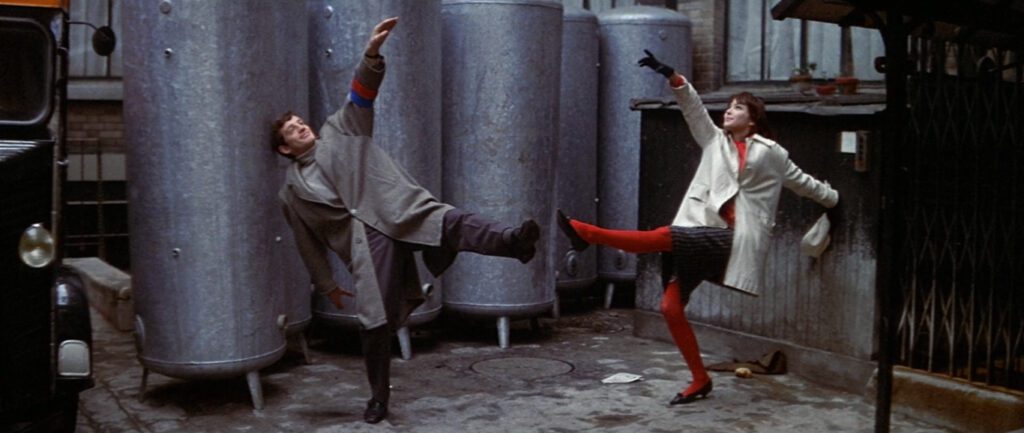
The title itself is a symbolic instance of total honesty – the tautological wording makes it self-evidently true. When Alfred asks Angela what she’s thinking, she replies, “I’m thinking that I exist,” paraphrasing the foundation of Descartes’ quest for truth – the truest thing a person can say. The recurring voice of a street vendor calls out names of French newspapers: “France-Soir, Paris Presse, Le Monde!” – symbols of raw reported truth. Characters speak with unusual honesty: Alfred tells a debt collector that he did indeed leave the Hotel Bikini without paying, and Angela readily admits to Émile that she slept with Alfred. Even when Angela lies to Émile, telling him “I don’t love you” or “I won’t forgive you”, she immediately lets the viewer in on the truth. Everyone’s motives are open: Angela wants a baby but Émile wants to wait; Alfred loves Angela. No one tries to cover reality with a facade of success; they all work at dead-end jobs, the couple’s neighbor is a prostitute, and the strip club is so unglamorous that we see its proprietor pick a towel and a bucket off the floor.
On the second day Alfred, seizing his chance with Angela, invites her to a restaurant where we get a nearly 13-minute treatise on the various forms of honesty. She begins by admitting “I’m late”; he says he’s been there “27 years” which was Belmondo’s age until April 1961. They sit down and admit their fears to each other. Alfred then tells a funny story of a girl who thinks she sent letters to her two lovers in the wrong envelopes, leading her to confess to both men and lose both needlessly. Next they discuss truth, and Angela asks him to tell a lie and a truth in sequence. He says “it’s raining” and “it’s sunny”, and she’s bothered that his expression doesn’t change to distinguish true from false. Suddenly two charlatans come posing as blind men, but Alfred recognizes them as co-informants to the police. He tells Angela how one of them had once written to all the pregnant women in his area, offering to reveal the sex of their babies for a thousand francs and refunding the money to the 50% he got wrong. She then asks him to play on the jukebox a Charles Aznavour song (“Tu t’laisses aller”) whose lyrics are the brutally frank words of a man who says his wife has grown unattractive. Alfred shows Angela a photo of Émile with another woman, and he tries to prove his love by banging his head into a wall. Finally Alfred springs a trap of logic on the cashier to escape paying the bill.
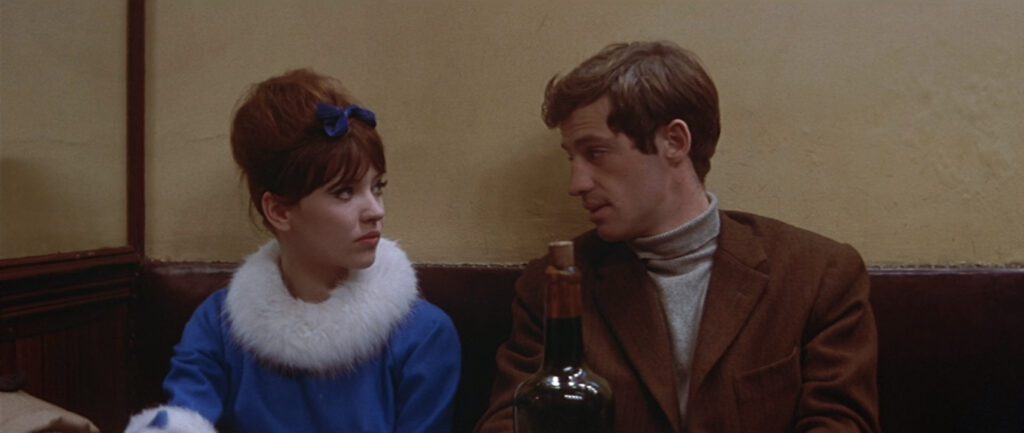
Throughout this restaurant scene Alfred’s idea of truth is always abstract, while Angela’s is rooted in emotion and instinct. Out of innate decency she admits she’s late, while he answers with inappropriate literalness, telling her how long he’s been on Earth. Alfred thinks his friend’s solicitation to pregnant women was honest because he gave refunds when he was wrong, but Angela, who anticipates being pregnant and doesn’t view things so abstractly, senses that it was a scam. The gap between them will evolve, four years later in Alphaville, into the gap between a computer who knows only literal truth and a human who counters the computer with paradox and emotion. Alfred, like Alpha-60, uses the truth to manipulate. He approves of his friend’s scam, he gets out of paying, and he tries to win Angela away from Émile.
In this restaurant scene, as in the movie itself, everything hinges on an idea of truth. The movie never sets out either to define truth or to prove a particular version of reality, but it continually probes for answers in the concrete material of life rather than engaging in detached speculation. It’s hardly a finished philosophical statement, but it introduces a language of cinema that will become a rich medium for philosophical expression in Godard’s next several films.
On her way home the first day Angela asks Alfred, “If you put an adjective before or after a word, does it affect the meaning?” The question is about syntax, which will be a lifelong preoccupation for Godard, particularly the syntax of film: how to put sounds and images together to express meaning honestly. A Woman Is a Woman may be full of fun and games, but it’s also busy inventing ways for movies to escape their habits of deception and manipulation. Its techniques go beyond Bertolt Brecht’s Verfremdungseffekt – their goal is not to create emotional distance nor to move the viewer onto a detached, abstract, or intellectual plane. Godard recognizes that narrative cinema is inherently emotional, and emotions are a key part of film syntax, holding movies to their humanity. The challenge is to introduce emotions without manipulating the viewer.
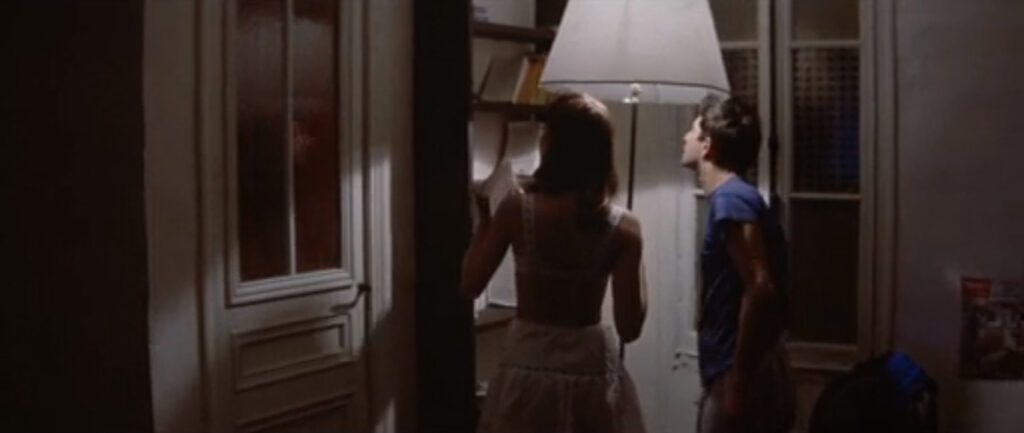
A Woman Is a Woman spans two days, each ending with Angela and Émile going to bed angry and unwilling to speak with each other. On each occasion the couple expresses their feelings by gathering books from their shelves and “speaking” via selected words on the books’ covers. The first night they trade insults – “Monster”, “Get stuffed”, “Torturer”, “Peruvian mummies”, “Con man”, “Sardine”, “All women to the stake” – absurd enough to defuse their anger and let them sleep, but not expressive enough to set things right. The next morning they’re still irritated at each other, but the second night Angela finds the words to make peace with Émile: “If you don’t love me, I’ll still love you.”
Each of these two scenes is set in a dark room with a lamp carried around conspicuously. This darkness and the single lamp happen to be basic elements of a movie theater. There’s something cinematic about what Angela and Émile are doing – communicating emotions in a darkened room using a syntax borrowed from the material around them. The first night they find only a string of nouns and short phrases, a syntax as limited as the series of postcards in Les carabiniers, but the second night Angela finds a complete sentence, and the words bring them together. If only movies, like Angela and Émile, could expand their syntax and move beyond simplicity and manipulation, we can hope that they too will manage to enrich our humanity.
CONNECTIONS:
Sherlock Jr. – Intent to expose the artifice of cinema
Citizen Kane – Textbook of cinematic devices
Le beau Serge – Film conceived as an effort at total honesty
Les carabiniers – Inexpressive string of nouns as a model of aggressive syntax
Alphaville – Contrast between literal, abstract truth and the complexity of paradox and emotion
Made in U.S.A – Character who says he’s been in a place for 27 or 127 years
Blade Runner – Meaningful allusion to Descartes’ statement “I think, therefore I exist.”
Dancer in the Dark – Musical film made, at least allegedly, in the style of a naturalistic film movement (Neorealism or Dogme 95)